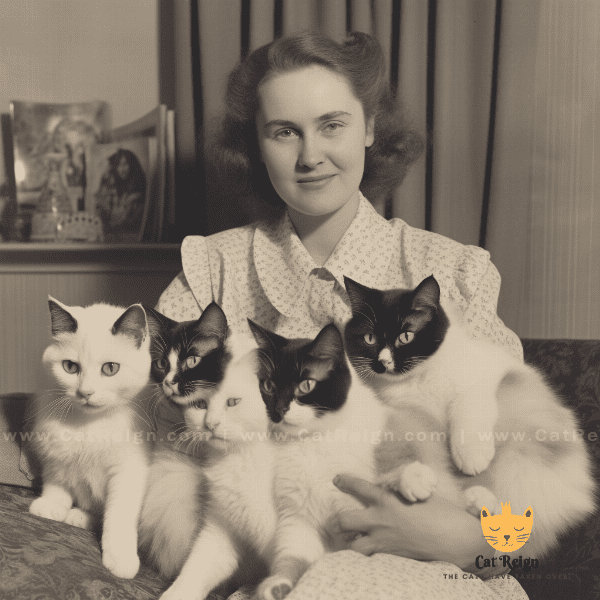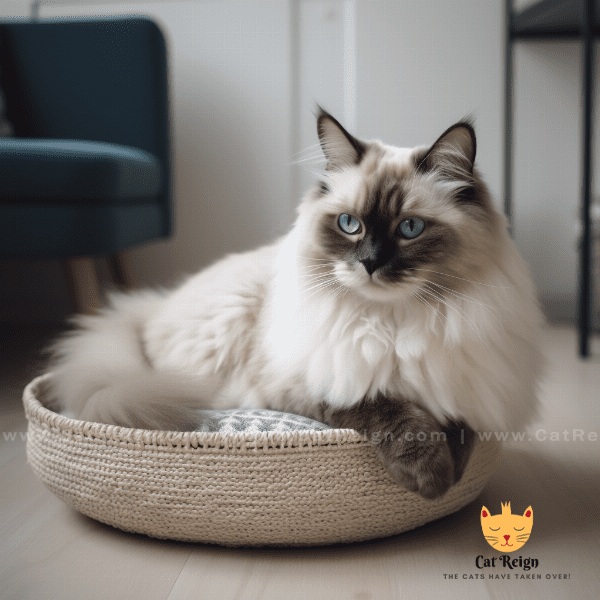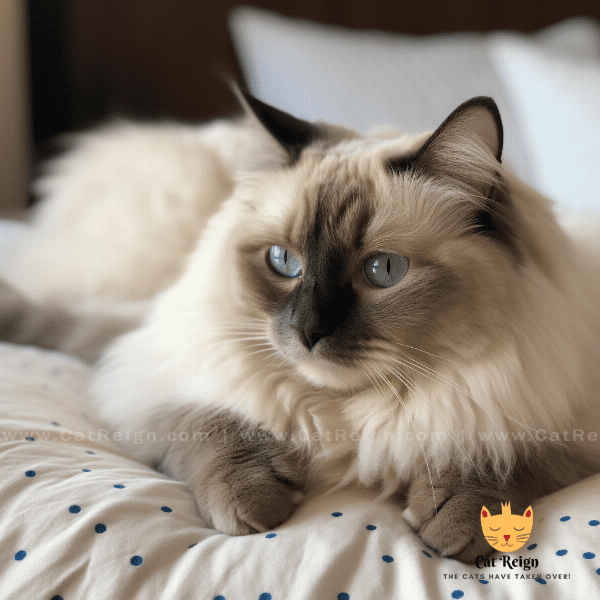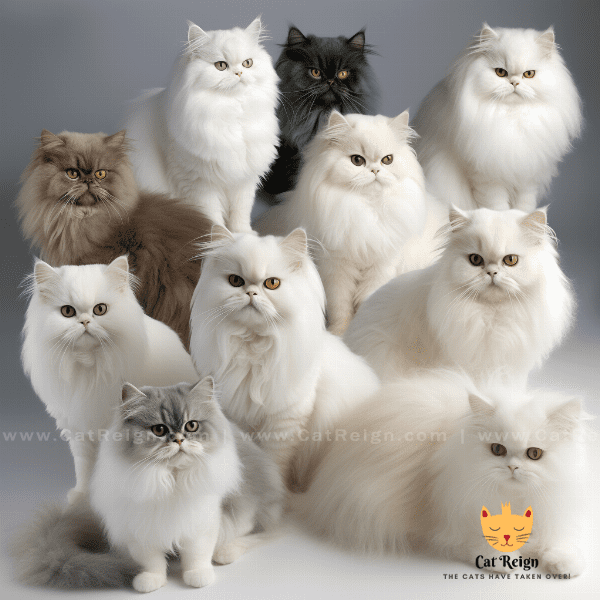Table of Contents
- What is a Ragdoll Cat?
- The History of Ragdoll Cats
- Characteristics and Physical Appearance
- Personality Traits and Temperament
- Health and Care Requirements
- Feeding and Nutrition for Ragdoll Cats
- Grooming and Hygiene Tips
- Training and Behavioral Issues
- Ragdoll Cats and Children
- Finding the Right Ragdoll Cat for You.
What is a Ragdoll Cat?
If you’re looking for a friendly and affectionate cat breed, then the Ragdoll cat might be the perfect match for you. Ragdoll cats are a large, semi-longhair breed that is known for their docile nature and loving personalities.
Appearance and Physical Characteristics
One of the distinctive features of Ragdoll cats is their size – they are one of the largest domestic Cat breeds, weighing between 10-20 pounds. They have a soft, silky coat that comes in a variety of colors and patterns, including seal, blue, chocolate, and lilac.
Ragdoll cats are known for their beautiful blue eyes and their docile and relaxed expressions, which earned them the nickname “puppy cats.” They have a muscular build and a broad chest that gives them a sturdy and robust appearance.
Personality and Temperament
Ragdoll cats are known for their gentle, friendly, and affectionate personalities, making them a great choice for families with children and other pets. They are social creatures that love to interact with their owners and enjoy being held and cuddled.
Unlike some other cat breeds, Ragdolls are not particularly independent and prefer to stay close to their human companions. They are intelligent cats and can learn to play fetch, as well as other tricks and behaviors.
Overall, Ragdoll cats are a fantastic choice for anyone looking for a loving, gentle, and loyal companion. In the next section, we will discuss the health and care requirements for Ragdoll cats to keep them happy and healthy throughout their lives.

The History of Ragdoll Cats
The history of Ragdoll cats is a fascinating tale that involves a unique breeding program and a passionate breeder named Ann Baker.
The Beginnings of Ragdoll Cats
In the 1960s, Ann Baker, a Persian cat breeder from Riverside, California, bred a white Angora cat named Josephine with a Birman cat. The resulting kittens had a unique personality and appearance, and Baker began to selectively breed them to create a new breed of cat that she called the “Ragdoll” cat.
The Controversy Surrounding Ragdoll Cats
Ann Baker’s breeding program was highly controversial, and she maintained strict control over the breeding of Ragdoll cats. She trademarked the name “Ragdoll” and insisted that only cats from her breeding program could be called Ragdolls.
Despite this controversy, the popularity of Ragdoll cats grew, and other breeders began to breed them as well, leading to the development of Ragdoll cat clubs and associations.
The Recognition of Ragdoll Cats
It wasn’t until the 1990s that the Ragdoll cat breed was officially recognized by cat breed registries. Today, Ragdoll cats are a popular breed around the world and are recognized by all major cat breed registries.
Overall, the history of Ragdoll cats is a unique tale of passion and controversy, but it has resulted in a beloved and popular breed of cat that is known for its loving personality and beautiful appearance. In the next section, we will discuss the physical characteristics and appearance of Ragdoll cats in more detail.

Characteristics and Physical Appearance
Ragdoll cats are known for their distinctive appearance and gentle personalities. In this section, we will discuss the physical characteristics of Ragdoll cats in more detail.
Size and Weight
Ragdoll cats are a large breed, with males weighing between 15-20 pounds and females weighing between 10-15 pounds. They are one of the heaviest cat breeds and have a sturdy and muscular build.
Coat and Color
Ragdoll cats have a long, soft, and silky coat that comes in a variety of colors and patterns. The most common coat colors for Ragdoll cats are seal, blue, chocolate, and lilac, although they can also have a bi-color or mitted pattern.
Body Structure
Ragdoll cats have a distinctive body structure that sets them apart from other cat breeds. They have a broad chest, muscular legs, and a long, thick tail. Their heads are wedge-shaped, and they have large, expressive eyes that are usually blue.
Temperament
Ragdoll cats are known for their gentle and friendly personalities. They are social cats and enjoy being around people and other pets. Ragdolls are not particularly independent and prefer to be close to their owners. They are intelligent cats and can learn to play fetch and other games.
Overall, the physical characteristics and appearance of Ragdoll cats make them a popular choice for cat lovers worldwide. In the next section, we will discuss the personality traits and temperament of Ragdoll cats in more detail.

Personality Traits and Temperament
Ragdoll cats are known for their friendly and gentle personalities, making them a popular choice for families and individuals looking for a loving companion.
Friendliness
Ragdoll cats are incredibly friendly and social cats. They are known to be very affectionate with their owners and enjoy spending time with them. Ragdolls are also known for their love of attention, and they will often follow their owners around the house seeking affection.
Docile Nature
One of the most notable personality traits of Ragdoll cats is their docile nature. They are known for their relaxed and easy-going demeanor and are often referred to as “puppy cats.” They are not prone to aggressive behavior and prefer to avoid confrontation.
Adaptability
Ragdoll cats are highly adaptable and can adjust well to different living situations. They are known for their ability to get along with other pets and children, making them an excellent choice for families.
Intelligence
Ragdoll cats are intelligent cats and can learn a variety of tricks and behaviors. They are also known to be excellent problem solvers and can figure out how to open doors and cabinets.
Vocalization
While Ragdoll cats are not particularly vocal, they will often communicate with their owners through soft meows and trills. They are not prone to excessive meowing or yowling and are generally a quiet breed of cat.
Overall, the personality traits and temperament of Ragdoll cats make them an excellent choice for cat lovers looking for a gentle and affectionate companion. In the next section, we will discuss the health and care requirements for Ragdoll cats.

Health and Care Requirements
Ragdoll cats are generally a healthy breed, but like all cats, they require proper care and attention to ensure they stay healthy throughout their lives.
Diet and Nutrition
Ragdoll cats have specific dietary requirements and need a balanced diet that includes protein, fats, and carbohydrates. It is essential to feed your Ragdoll cat a high-quality cat food that meets their nutritional needs. You should also provide your cat with fresh, clean water at all times.
Grooming and Hygiene
Ragdoll cats have long, silky coats that require regular grooming to prevent matting and tangling. You should brush your cat’s coat at least once a week and more frequently during shedding season. It is also essential to keep your Ragdoll cat’s teeth clean and provide them with regular dental care.
Exercise and Playtime
Ragdoll cats are a relatively inactive breed and do not require a lot of exercise. However, it is still essential to provide your cat with opportunities to play and exercise. You can encourage your Ragdoll cat to play by providing them with toys and engaging them in interactive play.
Health Issues
While Ragdoll cats are generally a healthy breed, they are prone to certain health issues, including hypertrophic cardiomyopathy (HCM), which is a heart condition. It is important to have your Ragdoll cat regularly checked by a veterinarian to detect any health issues early.
.

Feeding and Nutrition for Ragdoll Cats
Dietary Requirements
Ragdoll cats require a well-balanced diet that is rich in protein, fat, and carbohydrates. They also require specific nutrients such as taurine, which is essential for their heart health.
It is essential to feed your Ragdoll cat a high-quality cat food that meets their nutritional needs. You should choose a cat food that is formulated specifically for their age, weight, and activity level.
Wet vs. Dry Food
Ragdoll cats can be fed a diet of either wet or dry cat food. Wet cat food provides more moisture and can be beneficial for cats that do not drink enough water. However, dry cat food can be more convenient and easier to store.
It is important to ensure that your Ragdoll cat receives adequate hydration, regardless of the type of food they are fed. You should always provide your cat with fresh, clean water at all times.
Feeding Schedule
It is important to establish a regular feeding schedule for your Ragdoll cat. Feeding your cat at the same time each day can help regulate their digestion and prevent overeating. You should also ensure that you are not overfeeding your cat, as obesity can lead to health problems.
Treats and Supplements
While treats can be a great way to bond with your Ragdoll cat, they should be given in moderation. Treats should not make up more than 10% of your cat’s diet, as overfeeding can lead to weight gain.
Supplements may also be beneficial for your Ragdoll cat, particularly if they have specific health issues. However, you should always consult with your veterinarian before adding any supplements to your cat’s diet.

Grooming and Hygiene Tips
Ragdoll cats have long, silky coats that require regular grooming to keep them healthy and free of tangles and mats. In this section, we will discuss some grooming and hygiene tips for Ragdoll cats.
Brushing
Regular brushing is essential for maintaining your Ragdoll cat’s coat. You should brush your cat at least once a week and more frequently during shedding season. A metal comb or slicker brush can be used to remove any tangles or mats from your cat’s coat.
Bathing
While Ragdoll cats do not require frequent bathing, you may want to bathe your cat occasionally to keep their coat clean and shiny. Use a mild cat shampoo and make sure to rinse your cat thoroughly.
Nail Trimming
It is important to keep your Ragdoll cat’s nails trimmed to prevent them from becoming too long and sharp. You can use a pair of cat nail clippers to trim your cat’s nails. Be sure to avoid cutting the quick, which is the pink part of the nail that contains blood vessels and nerves.
Dental Care
Dental care is an essential aspect of your Ragdoll cat’s hygiene. You should brush your cat’s teeth regularly to prevent the buildup of plaque and tartar. You can use a soft-bristled toothbrush and a specially formulated cat toothpaste to brush your cat’s teeth.
Ear Care
It is important to check your Ragdoll cat’s ears regularly for signs of infection or ear mites. You can clean your cat’s ears with a cotton ball or soft cloth dampened with a gentle ear cleaning solution.
Overall, regular grooming and hygiene are essential for maintaining the health and well-being of your Ragdoll cat. In the next section, we will discuss training and behavioral issues in Ragdoll cats.

Training and Behavioral Issues
Ragdoll cats are known for their gentle and friendly personalities, but like all cats, they may exhibit certain behavioral issues that require training and attention. In this section, we will discuss some training and behavioral issues in Ragdoll cats.
Litter Box Training
Most Ragdoll cats are relatively easy to litter box train, but accidents can still happen. If your Ragdoll cat is not using the litter box, you may need to try different types of litter or litter box designs to find one that your cat prefers.
Scratching
Ragdoll cats have a natural instinct to scratch, which can lead to damage to your furniture and belongings. To prevent your cat from scratching your furniture, you should provide them with a scratching post or pad and encourage them to use it.
Training
Ragdoll cats are intelligent cats and can be trained to perform a variety of tricks and behaviors. Positive reinforcement techniques, such as rewarding your cat with treats or praise, can be effective in training your Ragdoll cat.
Separation Anxiety
Ragdoll cats are social cats and can develop separation anxiety if they are left alone for extended periods. To prevent separation anxiety, you should provide your Ragdoll cat with plenty of social interaction and playtime.
Aggression
While Ragdoll cats are generally gentle and friendly, they may exhibit aggressive behavior if they feel threatened or anxious. It is important to understand your cat’s body language and behavior and provide them with a safe and secure environment.
Overall, training and addressing behavioral issues in your Ragdoll cat can help ensure that they live a happy and healthy life. In the final section, we will provide some additional tips for caring for your Ragdoll cat.

Ragdoll Cats and Children
Ragdoll cats are known for their friendly and gentle personalities, which make them a great choice for families with children. However, it is essential to ensure that both your cat and children are safe and happy in each other’s company.
Supervision
It is important to supervise young children when they are interacting with your Ragdoll cat. Children should be taught how to handle cats gently and to respect their space and boundaries. Cats can become frightened or aggressive if they feel threatened or overwhelmed, so it is important to supervise all interactions between your cat and children.
Teaching Responsibility
Caring for a pet can be a great way to teach children responsibility and empathy. You can involve your children in the care and feeding of your Ragdoll cat, but it is important to ensure that they understand the importance of proper care and hygiene.
Gentle Play
Ragdoll cats enjoy playing and interacting with their owners, but it is important to ensure that playtime is gentle and non-threatening. Cats can become overstimulated or aggressive during playtime, so it is important to watch for signs of stress or anxiety.
Safe Space
It is important to provide your Ragdoll cat with a safe and secure space where they can retreat if they feel overwhelmed or anxious. This can be a separate room or a cozy cat bed where your cat can relax and feel secure.
Health and Hygiene
It is important to ensure that your Ragdoll cat is up-to-date on all of their vaccinations and receives regular veterinary care. You should also teach your children about proper hygiene, including washing their hands after handling the cat or cleaning the litter box.
Overall, Ragdoll cats can make great companions for families with children, but it is important to ensure that both your cat and children are safe and happy in each other’s company. With proper care and attention, your Ragdoll cat can become a beloved member of your family for many years to come.

Finding the Right Ragdoll Cat for You.
If you are considering adding a Ragdoll cat to your family, there are several factors to consider when choosing the right cat for you. In this section, we will discuss some tips for finding the perfect Ragdoll cat for your home.
Breeders
When choosing a Ragdoll cat, it is important to find a reputable breeder who can provide you with a healthy and well-socialized cat. You should research breeders in your area and ask for references before making a decision.
Age and Gender
Ragdoll cats come in both male and female genders and a range of ages. You should consider your lifestyle and preferences when choosing the age and gender of your Ragdoll cat.
Personality
Ragdoll cats are known for their gentle and friendly personalities, but each cat has its own unique personality. You should spend time with the cat before adopting to ensure that their personality and temperament are a good match for your family.
Health
When adopting a Ragdoll cat, it is important to ensure that they are in good health. You should ask for a health certificate and verify that the cat has received all of its vaccinations and veterinary care.
Adoption vs. Purchase
While purchasing a Ragdoll cat from a breeder is an option, there are also many Ragdoll cats available for adoption from animal shelters and rescue organizations. Adopting a cat can be a great way to provide a loving home to a cat in need.
Overall, finding the right Ragdoll cat for your home requires careful consideration and research. With proper care and attention, your Ragdoll cat can become a beloved member of your family for many years to come.




